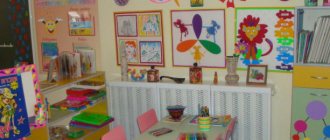Senior group. Senior preschool age. Children 5-6 years old
Educational and creative project for children 4–5 years old “Sorceress Autumn”
Explanatory note Problem: The ideas of children of the fourth year of life about objects of nature and the seasons in general are not yet stable enough, and practical, labor skills are just beginning to form. Relevance: The topic of this project was not chosen by chance. I want to…
Educational and creative project for children of senior preschool age “Mother Stove” Municipal preschool educational institution “Kindergarten No. 14 “Rodnichok”
general developmental type"
"Mother Pechka"
Author: Klisheva Natalya Albertovna, teacher Novodvinsk 2021 1.Introduction Relevance It has been written about the importance of introducing a child to the culture of his people...
Short-term project in the senior group “Magic and Colors”
Children finish drawing bubbles. As the drawing progresses, guiding questions are asked, if necessary.
- Reflection.
Game “Good - Bad” (TRIZ)
Additional education teacher:
Guys, tell me, what's good about bubbles?
Children:
They are beautiful, you can play with them, they make us happy.
Additional education teacher:
What's wrong with bubbles?
Children:
They burst and can get into your eyes and sting.
Additional education teacher:
Well done, you know everything!
Additional education teacher:
So you and I have achieved real magic, a real miracle.
-Let's see who did what they did (works are being examined, the additional education teacher praises the children for their invention and resourcefulness).
-Guys, did you like drawing with bubbles?
-What was the most difficult thing for you?
-What's easy?
Children share their impressions.
Guys, you also drew bubbles today and I suggest finishing them in the group and organizing an exhibition of works called “The Tale of Soap Bubbles”
Consultation for parents
«
Drawing in unconventional ways"
The development of the creative potential of an individual should be carried out from early childhood, when a child, under the guidance of adults, begins to master various types of activities, including artistic ones. Great opportunities for the development of creativity lie in visual arts and, above all, drawing. Drawing is an important means of aesthetic education: it allows children to express their ideas about the world around them, develops fantasy and imagination, and makes it possible to consolidate knowledge about color and shape. In the process of drawing, the child improves his powers of observation, aesthetic perception, aesthetic emotions, artistic taste, creative abilities, and the ability to independently create something beautiful using accessible means. Drawing classes develop the ability to see beauty in the surrounding life, in works of art. Own artistic activity helps children gradually approach an understanding of works of painting, graphics, sculpture, and decorative and applied art. The image in the drawings is created using a variety of materials. Artists use various materials in their work: various chalks, paints, charcoal, sanguine, pastels and much more. And in children's creativity it is also necessary to include different paints (gouache, watercolor), ink, crayons, and teach children to use these visual materials in relation to their means of expression. Experience shows that drawing with unusual materials and original techniques allows children to experience unforgettable positive emotions. Emotions, as we know, are both a process and a result of practical activity, primarily artistic creativity. By emotions one can judge what pleases, interests, depresses, worries the child at the moment, what characterizes his essence, character, and individuality. Preschoolers, by nature, are able to sympathize with a literary hero, to play out various emotional states in a complex role-playing game, but to understand what beauty is and learn to express oneself in visual activity is a gift that one can only dream of, but it can also be taught. We adults need to develop a sense of beauty in a child. It depends on us how rich or poor his spiritual life will be. It should be remembered: if the perception of beauty is not supported by the child’s participation in the creation of beauty, then, as they say, “infantile enthusiasm” is formed in the child. In order to instill a love of fine art and arouse interest in drawing starting from early preschool age, it is necessary to use non-traditional methods of depiction. Such unconventional drawing gives children a lot of positive emotions, reveals the possibility of using objects well known to them as artistic materials, and surprises them with their unpredictability. Unusual methods of drawing captivate children so much that, figuratively speaking, a real flame of creativity flares up in the group, which ends with an exhibition of children's drawings. What non-traditional painting methods can you use at home? Blotography, salt painting, finger painting. Soap bubbles, splashing, etc. Wouldn't you like to know what happens when you draw with a rag or crumpled paper? You can draw however you want and with anything! Lying on the floor, under a table, on a table... On a leaf of a tree, on a newspaper... The variety of materials poses new challenges and forces you to come up with something all the time. And from the scribbles and scribbles, a recognizable object eventually emerges - the Self. The uncomplicated joy of satisfaction from the fact that “I did this - it’s all mine!” Having learned to express his feelings on paper, the child begins to better understand the feelings of others, learns to overcome shyness, fear of drawing, of the fact that nothing will work out. He is confident that it will work out, and it will turn out beautifully. Mastering various materials, ways of working with them, and understanding their expressiveness allows children to use them more effectively when reflecting their impressions of the life around them in drawings. The variety of visual materials makes visual activity more attractive and interesting, and as children master different materials, they develop their own style of depiction. One of children's favorite ways to draw unconventionally is painting with salt. It not only has interesting decorative capabilities, but is also very easy to use. Children love to draw and...with soap bubbles. You can draw using the blowing method. But you can draw with a toothbrush, cotton wool, your finger, your palm, a tampon, crumpled paper, a tube driving paint (a drop) across a sheet of paper, print with different objects, create compositions with a candle, lipstick, feet... Go ahead, get creative! And joy will come to you - the joy of creativity, surprise and unity with your children. Drawing art has a variety of techniques and they should be used when working with children. The use of various materials enriches children with knowledge of how to work with them, their visual capabilities, will make children's drawings more interesting, and will increase the aesthetic side of the drawing.
Origami
Stock. Adults also make paper crafts with children in the older group. Paper crafts develop baby's logic and fine motor skills.
To make an origami “Dog” you will need a square of yellow paper, three small black squares, a black pencil, glue and scissors.
We recommend reading:
- DIY wall panel using scrap materials
Easter crafts: the best ideas for DIY gifts and decorations (90 photos + video)
Autumn crafts - 100 photos of themed crafts for children's creativity. Review of the best ideas and new products to create at home
- A yellow sheet of paper is folded in half and unfolded to mark the middle of the sheet.
- The opposite corners of a yellow sheet of paper are folded in half. It turns out to be a triangle.
- A sheet of paper folded into a triangle is placed in front of you with the fold facing up.
- The corners are bent down from the top. These will be the dog's ears.
- The lower sharp end is folded to the top. This represents the chin.
- Eyes are cut out from 2 black squares, simply rounding the corners, you get circles. They are glued to the top of the muzzle.
- In the third black square, the opposite corners are folded together and the lower sharp bent end of the chin is glued together with the resulting triangle.
- Draw a mustache with a black pencil.
Working with 5-6 year old children
Children can make crafts from natural materials in the older group.
Stock. To do this you need a sheet of white paper, a white square, colored pencils, glue with a brush, two small rowan brushes and scissors.- The teacher draws a silhouette of a girl or boy on a sheet of paper. The white square is folded in half and the corners are rounded off with scissors. It is smeared with glue and glued to the upper part of the figure, to the head area.
- The cuttings of maple leaves are shortened and the remainder of the cutting is smeared, capturing the leaf with glue.
- Next, the leaves are glued with the cuttings up onto the doll’s silhouette. It should be glued frequently so that the doll’s dress is fluffy and voluminous.
- Leaves cover the top of the white circle. This is doll hair.
- Rowan tassels should be glued to the sides of the head; they will indicate earrings.
- The kids will paint their faces as they wish. The eyes can be marked by gluing oblong green lilac leaves, narrowing them slightly.
In the same way, you can glue maple leaves onto a boy figurine.

